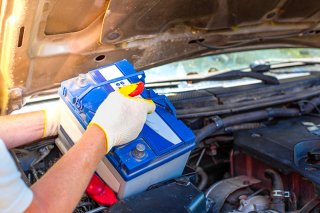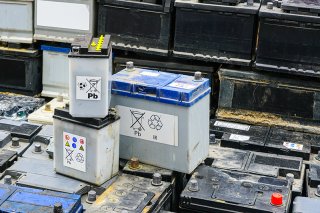Battery Collection in Action Case Study: The Lead-Acid Battery Collection Network
On this page:
Introduction

The U.S. lead-acid battery collection network is a particularly successful example of circularity that has operated nationally since the 1960s. The network is led by industry and provides battery drop-off locations at retailers, car dealerships, and municipal household hazardous waste sites. Unlike small and mid-format lithium-ion batteries, the lead-acid batteries used in vehicles are typically not handled directly by consumers, so retailers and dealers manage collection and recycling of these batteries.
As noted in EPA's 2018 Advancing Sustainable Materials Management fact sheet (pdf) (4.9 MB), the United States recycles lead-acid batteries the most out of all products, recycling 99 percent of them each year. This success is due to state-level disposal bans, consumer incentives from battery core charges ($5 to $20), and strong industry partnerships that support a robust collection system. A core charge is a dollar amount paid by the consumer in the form of a deposit when purchasing a lead-acid battery. When a consumer returns the battery, that core charge is refunded. The state decides the dollar amount for the core charge.
According to the Battery Council International, the lead-acid battery industry supports over 100,000 jobs and contributes $15 billion to the U.S. gross domestic product. This gross domestic product contribution represents the total value of goods and services produced by the U.S. lead-acid battery industry. While collection access exists in all 50 states, the lower 48 benefit most from easier access to collection sites and transportation options. Remote and island communities face transportation and logistics challenges.
Environmental regulations and economic incentives bolster the lead-acid battery collection and recycling network. Due to lead's high toxicity, improper disposal can harm human health and the environment. According to EPA's waste and debris fact sheet on auto batteries, state landfill bans and recycling incentives promote proper disposal. The high recyclability of lead compared to elements like nickel and cobalt also benefits the industry, supporting the continued momentum and operation of the lead-acid battery collection system in the United States.
Program Design and Implementation
Converging environmental and economic factors drove the expansion of the lead-acid battery collection network. Before the passage of the Resource Conservation and Recovery Act in 1976, many lead-acid batteries ended up in junkyards, where their lead and electrolyte content contaminated soil and water, posing significant health risks.
- RCRA classified end-of-life lead-acid batteries as hazardous waste requiring specific handling and disposal processes but also established alternate standards to encourage recycling. These requirements, along with increased public awareness of environmental impacts, prompted manufacturers to enhance the lead-acid battery collection and recycling network. In 1989, Battery Council International drafted the BCI Model Battery Recycling Legislation to support these efforts. This model law helped states ban improper disposal and promote recycling through sections on land disposal bans, mandatory retailer take-back signage (pdf) (195 KB), a core-charge model, and requirements for retailer and wholesaler acceptance of used batteries (pdf) (195 KB). Forty-five states have enacted legislation based on this model, while the remaining states (Alabama, Alaska, Delaware, Maryland, and Montana) and U.S. territories (American Samoa, Guam, the Northern Mariana Islands, Puerto Rico, and the U.S. Virgin Islands) still provide collection through retailer take-back and household hazardous waste programs.
Unlike state or municipal programs, the lead-acid battery collection and recycling network is industry-funded and built on commercial agreements among recyclers, manufacturers, and retailers. Key players include:
- Manufacturers like Clarios, East Penn, and Stryten.
- Recyclers like EcoBat and Gopher Resource
- Retailers like AutoZone, Costco, and Batteries Plus.
Manufacturers pay retailers for end-of-life batteries, and refundable consumer core chargesConsumer core charges are dollar amounts paid by consumers in the form of deposits when purchasing items such as lead-acid batteries. encourage higher collection rates. The batteries circulate through a system of collection, recycling, and reuse. In some cases, recyclers pay state, Tribal, or local household hazardous waste programs for batteries, maintaining an efficient system.
How it Works

When consumers return a lead-acid battery to a retailer or car dealership, they receive back their core charge—the deposit paid at purchase. Household hazardous waste programs that collect lead-acid batteries from consumers and sell them to recyclers can use this income to offset operating costs and other expenses. Retailers may also negotiate deals with battery manufacturers and processors, obtaining discounts on new batteries in exchange for used ones. Manufacturers and processors benefit by acquiring valuable lead and plastic to produce new batteries, reducing their need for new materials. Due to this circular economy, new U.S.-made lead-acid batteries contain over 80 percent recycled material, according to a 2025 Battery Council International study.
What Works Well
The success of the lead-acid battery collection and recycling network relies on collaboration among battery manufacturers, recyclers, retailers, and consumers. Widespread retailer participation offers thousands of collection points, making the network accessible, convenient, and profitable for all parties involved. While environmental legislation initiated this network, the network’s ease of access for consumers and its profitability for retailers and manufacturers has scaled operations.
The network succeeds by providing consumers with financial incentives to participate—it operates on the principle that consumers need a reason to return a product. In addition to financial incentives, the network provides convenience for consumers. Unlike small-format batteries Small format batteries are those under 4.4 pounds and rechargeable batteries under 11 pounds including removable and embedded batteries in electronics and electric devices. in various products, most lead-acid batteries are specific to vehicles and industrial applications, and consumers rarely handle them. The network does not require consumers to manage batteries at end-of-life, thereby streamlining the collection and recycling process.
Challenges Encountered
Island and remote communities face challenges in accessing lead-acid battery collection compared to suburban and urban areas. The U.S. Department of Transportation classifies end-of-life lead-acid batteries as hazardous material requiring special permits, labels, and containers for shipping, which complicates logistics, per a report from the Rechargeable Battery Association (pdf) (37.3 KB). Island communities often rely on air delivery for resources and may lack on-the-ground facilities to properly collect, store, and ship end-of-life batteries to recycling facilities. Environmental contamination can occur when consumers, retailers, or household hazardous waste sites have no disposal options.
While lead-acid battery recycling effectively recovers lead and plastic, it can pose health risks to nearby communities if not properly controlled. Pyrometallurgical recycling, the most common method, involves crushing batteries to separate acid from metal, lead, and plastic, followed by sorting and liquefying metallic materials with extreme heat. This process emits airborne lead particles, which can contaminate the surrounding area if proper emissions controls are not used. EPA requires that U.S. recyclers operate under strict permitting requirements.
Insights and Next Steps
The lead-acid battery collection and recycling network is successful due to its consistent processes, regulatory measures, and economic incentives, offering a model for developing programs for other battery chemistries:
- Consistent collection and recycling processes. Consumers receive clear instructions on where to return lead-acid batteries, enhancing convenience. Uniform chemistry allows easy sorting, shipping, and recycling without contamination risks, as all lead-acid batteries undergo the same recycling process.
- Mandatory participation and regulatory measures. The network combines industry agreements with state-level mandates in states with relevant legislation. Mandatory take-back policies require manufacturers and retailers to accept batteries, and disposal bans prevent landfill disposal.
- Economic incentives. Financial incentives drive participation across the network. Core charges motivate consumers to return batteries, while agreements between retailers, manufacturers, and recyclers offer economic benefits and foster partnerships.
